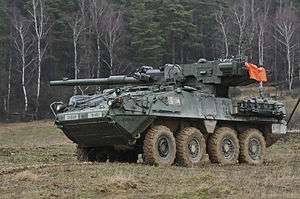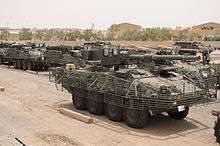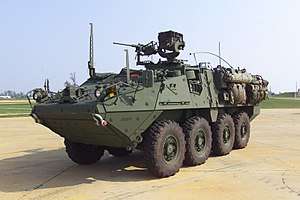M1128 Mobile Gun System
| M1128 Mobile Gun System | |
|---|---|
 A M1128 Mobile Gun System during a training exercise in 2015 | |
| Type | Assault gun |
| Place of origin | United States / Canada |
| Specifications | |
| Weight | 18.77 tonnes (20.69 short tons; 18.47 long tons) |
| Length | 6.95 m (22.92 ft) |
| Width | 2.72 m (8.97 ft) |
| Height | >2.64 m (>8.72 ft)[1] |
| Crew | 3 |
|
| |
| Armor | 14.5 mm resistant[2] |
Main armament | M68A2 105 mm cannon |
Secondary armament | M2 .50 caliber machine gun; M240C coaxial machine gun; 2, M6 smoke grenade launchers |
| Engine |
Caterpillar 3126 turbo diesel 260 kW (350 hp) |
| Power/weight | 14 hp/ton |
| Transmission | Automatic 6 forward, 1 reverse |
| Suspension | 8×8 wheeled |
| Ground clearance | 15 in (38 cm) |
| Fuel capacity | 56 gallons (212 liters) |
Operational range | 330 miles (528 km) |
| Speed | 60 mph (96 km/h) |
The M1128 Mobile Gun System is an eight-wheeled armored car of the Stryker armored fighting vehicle family, mounting a 105 mm tank gun, based on the Canadian LAV III light-armored vehicle manufactured by General Dynamics Land Systems. It is in service with the United States[3] and was also being considered for adoption by several other countries.
Design
Firepower

The MGS' low profile turret has a small silhouette, is stabilized and mounts a 105mm M68A2 rifled cannon with an autoloader. The vehicle is primarily outfitted to support infantry combat operations. While it could take on some of the roles of tanks, it is not designed to engage in combat with tanks. The MGS can store 18 rounds of main gun ammunition, 8 in the autoloader's carousel and an additional 10 in a replenisher located at the rear of the vehicle.[4] It has a rate of fire of six rounds per minute.[5]
The MGS' 105 mm cannon can fire four types of ammunition: the M900 kinetic energy penetrator to destroy armored vehicles; the M456A2 high explosive anti-tank round to destroy thin-skinned vehicles and provide anti-personnel fragmentation; the M393A3 high explosive plastic round to destroy bunkers, machine gun and sniper positions, and create openings in walls for infantry to access; and M1040 canister shot for use against dismounted infantry in the open.[6][7]
Crew amenities
Because the vehicle was originally designed without air conditioning, crews are given individual cooling vests that circulate cooled water from outside the vehicle to the garment. Vehicle computers still overheat regularly. The large weapon station and relatively smaller hatch can make emergency exits difficult.[5] Because the main cannon is separated from the crew compartment it is possible for the crew of an MGS to encounter a stoppage in the heat of battle and not be able to clear it without disembarking from the vehicle. All MGS Stryker platforms have since been upgraded with A/C units.[8]
Organization
The U.S. Army allocated nine Mobile Gun Systems to a battalion.[5] There were 27 Mobile Gun Systems per Stryker Brigade in 2013, but the Army is cutting the number per brigade to 10.[9] The Army bought 142 Mobile Gun Systems in total;[10] three were lost in combat. A three-vehicle MGS platoon operates organic to a Stryker infantry company, with one MGS in support of a Stryker infantry platoon.[11]
As of May 2017, a Stryker Brigade Combat Team is equipped with three platoons of MGS Strykers and three platoons of ATGM Strykers in its weapons troop.[12]
History

Development
In course of the Armored Combat Vehicle Technology (ACVT) Program, both the U.S. Army and the Marine Corps have let separate fixed price vehicle design study contracts to nine contractors. The nine contractors were: Alvis Ltd, Cadillac Gage, General Motors of Canada, Pacific Car and Foundry, Bell Aerospace, FMC Corporation, Chrysler (jointly with General Dynamics), Teledyne and AAI Corporation. The gun, officially designated as the Medium Caliber Anti-Armor Automatic Cannon (MCAAAC), has been already developed by Ares Inc.[13] During development the original Ares Inc. made replenisher proved to be problematic and was replaced with one made by Meggitt Defense.[14]
Procurement
Following the end of the Cold War some theorists believed that the existing suite of U.S. armored vehicles, designed largely to fight Soviet mechanized forces in Europe, were not well suited to the lower-intensity missions U.S. armed forces would be tasked with. This led to the development of a new armored fighting vehicle designed for lower-intensity combat, rather than large-scale battle.
Canada had liquidated about half of its fleet of Leopard 1s in the early 2000s, with the intention of replacing them with the airmobile Mobile Gun System, but the decision was reversed.[15]
Full-rate production has been indefinitely deferred as of 2012.[16]
In late 2013, the U.S. Army began seeking to reintroduce an airdroppable mobile airborne protected firepower platform to provide fire support for air assault forces, a capability that had been absent since the retirement of the M551 Sheridan in 1997. General Dynamics initially considered modifying the wheeled Stryker MGS to meet the requirement,[9][17] but the company instead developed the tracked Griffin light tank technology demonstrator as its offering for the Mobile Protected Firepower (MPF) platform, which was unveiled in October 2016.[18]
See also
References
- ↑ "CBC". http://www.cbc.ca/news2/background/cdnmilitary/equipment.html. External link in
|website=(help); Missing or empty|url=(help) - ↑ "Army Fact File – Stryker". Retrieved 2008-04-16.
- ↑ Soldiers train on Stryker gun system
- ↑ "Stryker mobile gun system replenisher". Meggitt Defense. Retrieved 30 July 2018.
- 1 2 3 Matthew Cox (4 February 2008). "Mobile Gun System brings the heat in Iraq". Gannett Government Media Corporation. Retrieved 28 August 2011. (subscription required)
- ↑ M1128 Stryker Mobile Gun System - Globalsecurity.org
- ↑ "Archived copy" (PDF). Archived from the original (PDF) on 2014-08-26. Retrieved 2014-08-22.
- ↑ "PM Keeps Strykers Combat Ready!" (PDF). Logistics Support Activity. Retrieved 30 July 2018.
- 1 2 Matthew Cox (20 September 2013). "Army Looks to Mount 30mm Cannons on Strykers". Military.com. Retrieved 22 September 2013.
- ↑ Uparmored Bradley Could Be Tough Enough For AMPV: Testers - Breakingdefense.com, 29 January 2014
- ↑ Stryker Mobile Gun System (MGS) - Office of the Director, Operational Test & Evaluation. 2013
- ↑ "Stryker Brigade Combat Team Weapons Troop" (PDF). Army Publishing Directorate. Retrieved 30 July 2018.
- ↑ Department of Defense Appropriations for 1983, pt. 5, p. 791.
- ↑ Ayers, Christian. "THE STRYKER MOBILE GUN SYSTEM: A CASE STUDY ON MANAGING COMPLEXITY" (PDF). Defense Technical Information Center. Retrieved 30 July 2018.
- ↑ Capt Brian Corbett (19 September 2007). "Canada's new main battle tank – Leopard 2". The Maple Leaf. Archived from the original on June 9, 2011. Retrieved 10 December 2009.
- ↑ Brannen, Kate. "AUSA: U.S. Army Plans Post-War Management of Stryker Fleet." Defense News. February 23, 2012.
- ↑ U.S. Army in the Market for ‘Light’ Tanks Archived 2016-01-19 at the Wayback Machine. - Nationaldefensemagazine.org, 7 October 2013
- ↑ General Dynamics presents new Griffin technology demonstrator of light tank for U.S. airborne troops - Armyrecognition.com, 5 October 2016
External links
![]()
